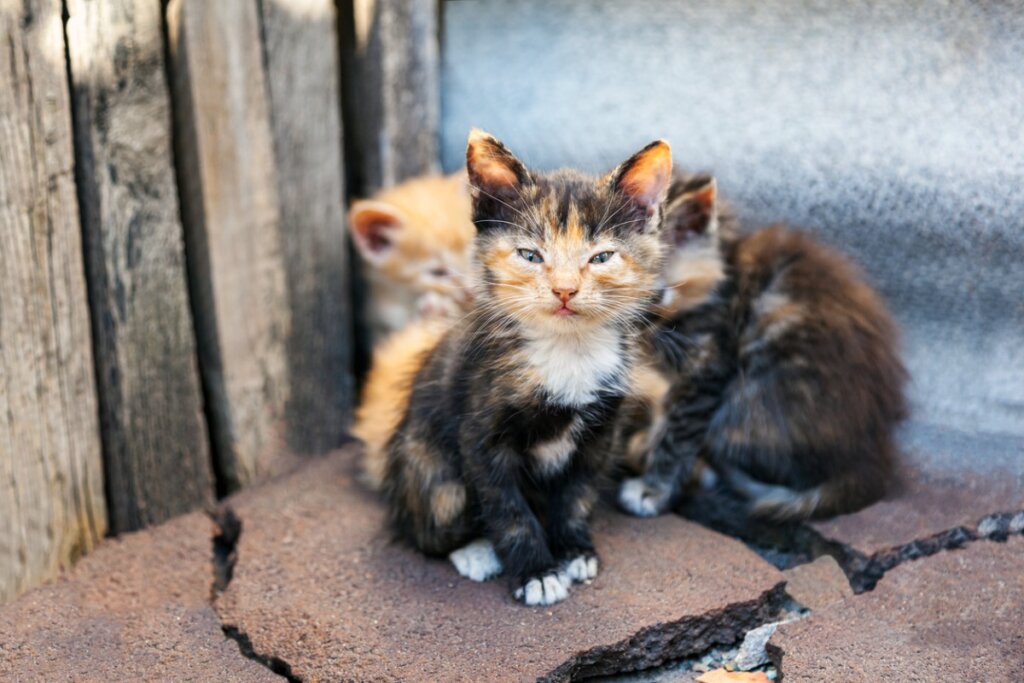Stray Cat Diseases: Which Are the Most Common?

The irresponsibility of certain owners has caused many pets to end up on the street. Fortunately, adoption has been one of the main strategies to remedy this situation. However, a stray cat or dog is more susceptible to contracting diseases that put their health and that of their owners at risk, so care must be taken when adopting them.
This doesn’t mean that taking in a homeless animal is bad, but you’ll need to go to a veterinarian to confirm their welfare. This doesn’t only prevent contagion, but also greatly improves the quality of life of the new member of the family. Keep reading to get to know some diseases that stray cats are more susceptible to.
Why do stray cats contract diseases more easily?
Stray cats spend their time outdoors, in places where there are many sources of infection. For this reason, it’s quite likely that they’ll catch a disease when trying to find food, for example. In addition, due to the malnutrition they often have, their body’s defenses don’t work properly and they end up deteriorating more as a result.
This, coupled with the fact that they’re constantly chased by dogs, people, or other cats, means that their overall health will always be weak, and they’ll be prone to suffer pathologies. This is the reason why, in most cases, a rehabilitation process is required before the cat can recover its original condition. This includes everything from veterinary care, to readaptation to human contact.

Stray cat diseases
Upon arrival at their new home, cats will live closely with their owners and other pets. Therefore, you’ll need to be attentive to any signs that could show the cat has an illness or disease. If not, the animal will become a dangerous focus of contagion for everyone. Here are some of the most common stray cat diseases.
Toxoplasmosis
Toxoplasmosis is a disease that infects different mammals (and some birds). It’s caused by a protozoan (Toxoplasma gondii), which can be contracted by eating infected rodents or living with sick cats. Stray cats, being exposed to the outdoors, are more likely to become infected.
In fact, this protozoan is able to modify the behavior of rats to make them lose their fear of cats. As a result, this makes it easier for homeless animals to become infected by eating these rodents. In addition to this, the feces of the infected feline spread toxoplasmosis, so if hygiene isn’t taken care of, family members can become ill.
The latter is important, as the infection in humans is very dangerous for pregnant women. So, if you want to adopt a cat, it’s best to avoid doing so during pregnancy. And don’t forget to take your cat to a vet to make sure its health is in optimal condition.
Rabies
Rabies is a disease caused by a virus transmitted in different types of animals. For infection to occur, the saliva of the infected organism must enter the body through an open wound. For this reason, it isn’t uncommon for stray cats to become infected through the bites of other wild organisms.
This disease alters the central nervous system and can lead to death. In fact, the lethality of rabies is 100%. And, if this weren’t enough, this disease can also infect the owners, and is nearly always fatal. To prevent this, take the necessary precautions to handle stray cats without letting them scratch, bite, or lick you.
Cat scratch disease
This disease is caused by scratches or bites from a cat infected with the Bartonelli henselae bacteria. Felines are infected by fleas or ticks that transmit the infection. However, many pets don’t show obvious clinical signs of the disease and it’s only visible if they attack a person.
The victim of the scratch will have some mild symptoms, including fever, headache, and swollen glands. These clinical signs usually subside without the need for close monitoring, although, if your immune system is weak, you may need medication.
Although it isn’t a risky disease, it’s best to avoid scratches from a stray cat.
Ringworm (feline dermatophytosis)
Ringworm is a disease of the skin caused by the fungus Microsporum canis. This type of pathology is very contagious due to the way the microorganism is infected. Without going any further, the fallen hairs of the sick animal can infect other pets without coming into direct contact.
This pathology starts as a small circular inflammation in the skin, which spreads and begins to produce desquamation. Fortunately, mild cases usually resolve spontaneously. However, in stray cats, veterinary follow-up is necessary, as malnutrition may prevent their immune system from working efficiently.
In addition, owners need to be very careful with this problem, as they’re also susceptible to catching it. It’s true that this disease doesn’t have serious consequences, but it’s best to avoid direct unprotected contact when rescuing felines from the street.
Feline immunodeficiency virus
Feline immunodeficiency virus (FIV) is very similar to the HIV virus that affects humans. This pathology causes the feline’s immune system to not function properly, which opens the door to several kinds of infections. Consequently, the stray cat can’t defend itself against other diseases and their complications.
This virus can only be transmitted from one cat to another and a stray animal is capable of infecting your pets if you aren’t careful. For this reason, you must take your new family member to the vet as soon as possible. This way, you’ll ensure that no one is at risk of infection. Also, keep in mind that this pathology can’t be passed on to humans.
Intestinal parasites
Endoparasites such as nematodes, worms, pinworms and coccidia are common pathogens in young cats. In addition, stray cats have a greater chance of infection because of their poor quality of life. Consequently, when the cat arrives at its new home, it could infect other members of the family.
These types of problems aren’t usually very dangerous, but, if they aren’t controlled, they could cause serious health conditions. Treatments to kill parasites are fast and effective.
Feline leukemia virus
This virus belongs to the same group as the feline immunodeficiency virus and causes the same immunosuppressive effects. In addition, it’s also transmitted when saliva comes into contact with open wounds. Therefore, it’s very easy for cats to be infected when several live in the same place.
In the case of stray cats, this disease is often transmitted when they fight each other, and when they arrive at a new home they can easily infect other pets. The feline leukemia virus infection was considered the major cause of death in these animals for a long time, although it’s currently on the decline thanks to preventive measures.
Cats can’t transmit this virus to humans, so the owner isn’t at risk of infection. Despite this, the infected feline must go through treatment in order to alleviate their symptoms.
Feline rhinotracheitis
Rhinotracheitis is a very contagious respiratory pathology in cats, as it’s dispersed through sneezing or secretions of the infected animal. It’s caused by herpes virus type 1 and calicivirus. These pathogens remain in the body even when there aren’t any symptoms. Consequently, an animal can be a point of infection throughout its life.
This disease is very common in catteries or in groups of felines, so stray cats are susceptible to infection. Rhinotracheitis isn’t usually lethal, but if the animal is very weak, fatal cases can occur. For this reason, it’s best to prevent the problem with a complete vaccination schedule for all pets.

Rescuing a stray cat is a life-changing, altruistic act. However, to ensure that the cat is in excellent health (and to protect their new family), it’s best to take them to the vet as soon as possible. Remember that this little cat hasn’t had an easy life, and it needs all the care it can get. Even so, rest assured that all your efforts to keep them healthy will certainly be worth it.
All cited sources were thoroughly reviewed by our team to ensure their quality, reliability, currency, and validity. The bibliography of this article was considered reliable and of academic or scientific accuracy.
- Ingram, W. M., Goodrich, L. M., Robey, E. A., & Eisen, M. B. (2013). Mice infected with low-virulence strains of Toxoplasma gondii lose their innate aversion to cat urine, even after extensive parasite clearance. PloS one, 8(9), e75246.
- Salamanca, C. A., Polo, L. J., & Vargas, J. (2011). Sobrepoblación canina y felina: tendencias y nuevas perspectivas. Revista de la Facultad de Medicina Veterinaria y de Zootecnia, 58(1), 45-53.
- Castro, F. F. C., & Rodríguez, M. P. M. (2016). Rabia en un gato doméstico (Felis silvestris catus) en el municipio de Yumbo, Valle del Cauca, Colombia. Revista UDCA Actualidad & Divulgación Científica, 19(1), 243-246.
- Flores, G. G. (2013). Enfermedad por arañazo de gato. Revista médica de Costa Rica y Centroamérica, 70(605), 109-111.
- Calle-Restrepo, J. F., Fernández-González, L., Marcela, L., & Morales-Zapata, J. R. S. (2013). Virus de la leucemia felina: un patógeno actual que requiere atención en Colombia. Vet Zootec, 7(2), 1-22.
- Pinales Hernández, I. L. (2020). Complejo respiratorio felino: factores de riesgo y detección molecular de agentes infecciosos selectos en gatos del área metropolitana de Monterrey, Nuevo León (Doctoral dissertation, Universidad Autónoma de Nuevo León).
- Chapela, V., Martínez, M., Ojeda, P., & Bidarte, A. (2010). Inmunodeficiencia felina y leucemia linfoide en gatos. Revista médica de homeopatía, 3(2), 68-70.
- Grandía, R., Entrena, Á., & Cruz, J. (2013). Toxoplasmosis en Felis catus: etiología, epidemiología y enfermedad. Revista de Investigaciones Veterinarias del Perú, 24(2), 131-149.
